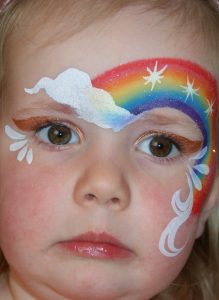Table of Contents
Overview
If you plan to host a party for kids or just want to prepare a fun and artsy activity for your little ones, face painting is a really good idea! Face painting is truly an enjoyable activity that includes a splash of color and creativity. It has also been a very well-loved activity for adults and children alike. It may be a lot easier for you to hire face painters, but if you want it to be more fun and interactive for you and your little one, you definitely do it on your own.
This post will be about the type of paint you should be using and some other tips and tricks. We will also teach you how to do a very easy design to do on your kid, so read on.
What type of paint for face paint
If this is the first time you have decided to do face painting as a family activity for you and your kids, you might still be confused about what type of paint to use. It is important that you will use those face paints that are safe for your children’s faces and delicate skin. Here are the most commonly used paints for face painting. Face paints can come in different forms, such as cake paints, crayons, cream, and liquid. You may also combine your face paint with glitter; just make sure you are using safe ones and will not irritate your child’s paints. We also recommend that you check your face paints if they are safe for children and are FDA-approved.
Grease-based face paint
Grease-based face paints are one of the classics and the oldest type of face paint being used. Performers commonly use this type, and if you want the face paint to last for a long period of time. Therefore, grease-based paints are ideal for parties since they are easy to blend, does not crack, and will not come off easily.
Cream-based face paint
Another type of commonly used face paints is cream-based ones. They are comparable to the texture of regular make-up and does not need to be activated by water. This type is also fairly easy to use, but you would not want to use this on younger children since this can take quite some time to dry up, and we know how kids can be impatient sometimes.
Powder-based face paint
Powder-based face paints are very versatile and can be used as both wet or dry. However, this type of face paint can be very messy, so it is generally recommended to be used by professionals.
Wax-based face paints
This type of face paint is one of the favorites since wax-based face paints are relatively easy to use and works great if you want to work on a detailed face paint masterpiece. This type of face paint is also very easy to apply with any brushes you have, plus it dries quickly, so it can be a good face paint to use if you have more than one kids to paint on.
Glycerin-based face paint
The glycerin-based ones are also very famous nowadays for professional and non-professional face painters since they are very easy to use and apply. This type of face paint can be applied using sponges and is fairly easy to blend and work with. However, you have to be patient when using this type of face paint since it dries slowly.
Organic face paint
Organic products have become famous nowadays, and that includes organic face paint. These organic face paints are commonly used for those people whose skin gets irritated pretty quickly. They also come in a wide range of colors, and they are easy to use.
Professional-grade face paint
Last but not least are professional-grade face paints. This type of face paint can be quite expensive, but they are definitely worth the money. Professional-grade ones are known to be safe and produce the most vibrant colors when applied to the face; they are also easy to use.
Choosing face paint for your kids
The first thing you might notice when choosing face paint for your kids are the colors, fancy packaging, and possibly low prices, but there are many more things to look at. You should be sure that the face paint you are getting will be safe for your kids and be easy to use.
Look for FDA-approved products.
Your kids and their skin’s safety is extremely important; that is why this consideration is vital. You have to look at the composition of the face paint you plan to buy and ensure that they are FDA approved. It is a smart idea to do away with buying very cheap ones since those kinds may be poorly made and possible, not complying with the FDA’s regulations. Also, it would be best if you buy products that are labelled in languages that you can understand. You must read the product so that you will know what is in the products and what are the ingredients that are used to make face paint. It is important to remember that compliant or FDA-approved products have a higher level of safety and are less likely to cause irritation and adverse reactions.
Possible skin irritation
When choosing face paints, it is also important to note if your child has had a previous skin irritation or allergic reactions to certain products or ingredients. If your kids have had a history of eczema or are being treated for acne, it would be best if you consult your dermatologist or physician before using any face paint on them. When doing face paint on your own, experts recommend avoiding sensitive areas of the face, such as the area around the mouth and eyes. A good way to avoid or minimize skin reactions is to use a barrier cream.
If your child has shown redness and complains of itchiness, it would be best if you stop face painting, immediately clean the area gently, and apply moisturizer. If the redness and itchiness do not get better, immediately consult your doctor.
Safety tips
First and foremost, you must get face paint from a reputable store that sells only trustworthy brands and FDA-approved products. Before starting with the face paint, remember to do a patch test on your child’s jaw area to check for allergic reactions. Remember that if you are doing a face paint activity with younger kids, remember to supervise them and keep the paints out of reach when storing them. And lastly, once you are done with your activity, always make sure that you thoroughly clean the paint from your child’s face to avoid irritation.
Can you use normal paint?
The quick answer to this question is no, and you definitely can not use any paint or normal paint on your kids’ faces. Make sure that you are only using paints that are made and formulated to be used on the face and should be safe and gentle enough to be used on children as well.
How do you face paint a bee?
Face painting a bee is an easy thing to do, and with just a set of three colors that include white, black, and yellow, you will be set to start painting on your little one’s face. Watch this bumblebee face painting tutorial for reference.

